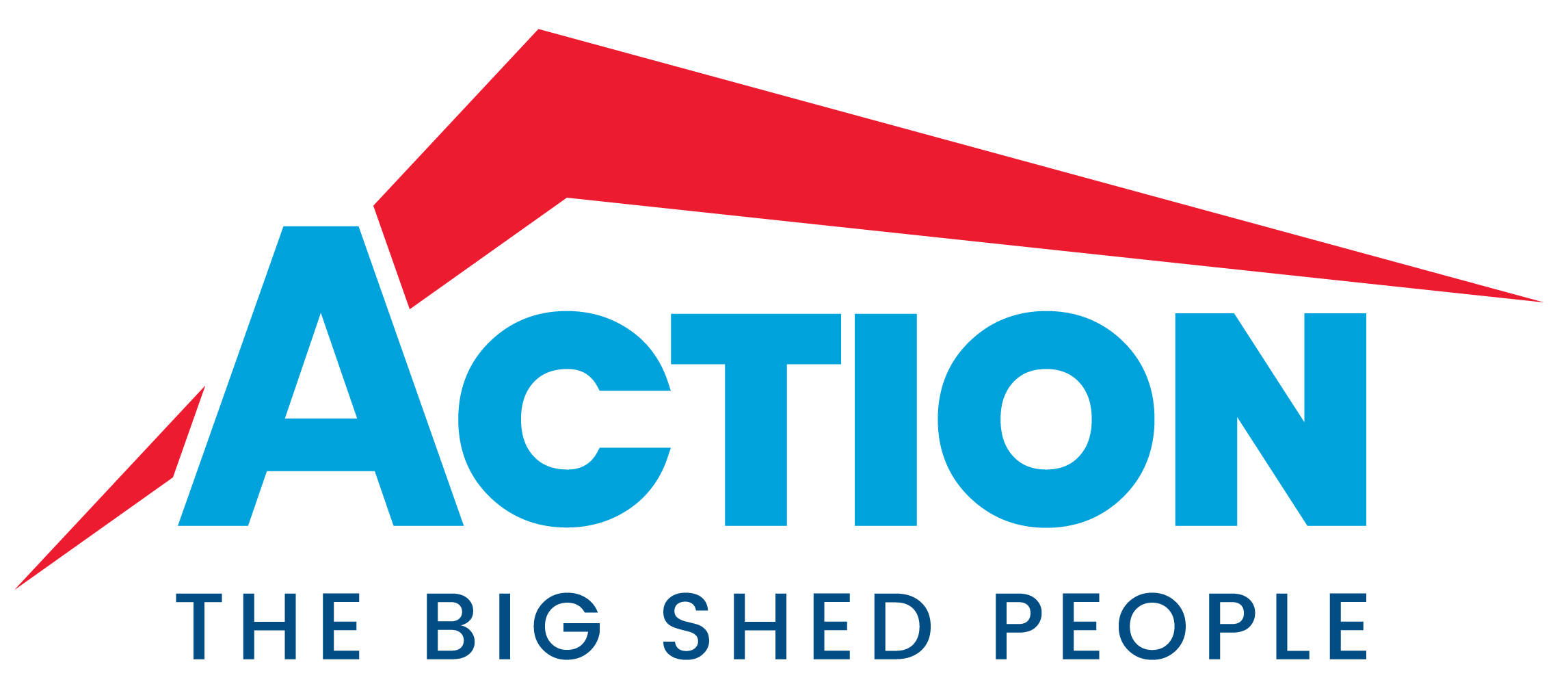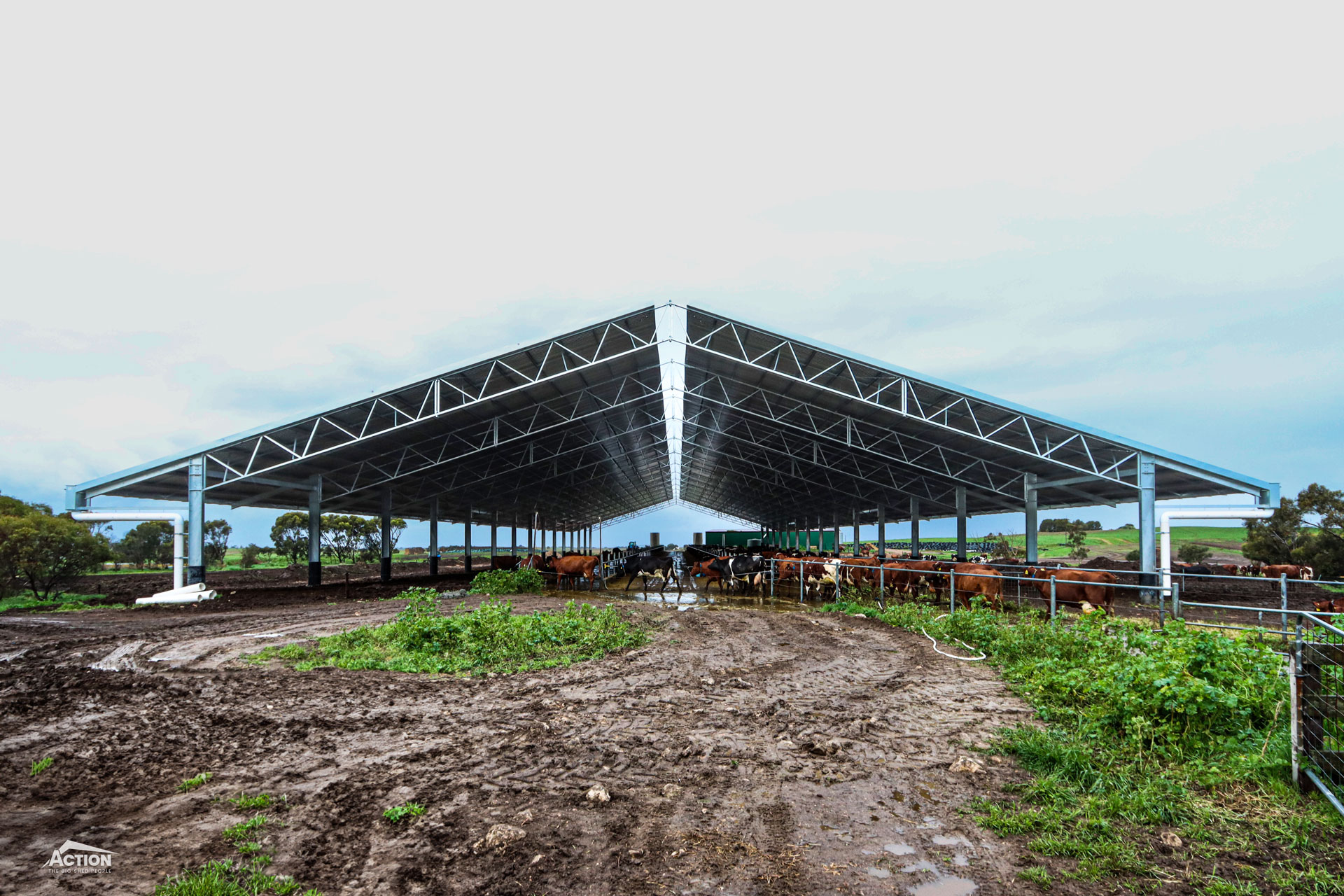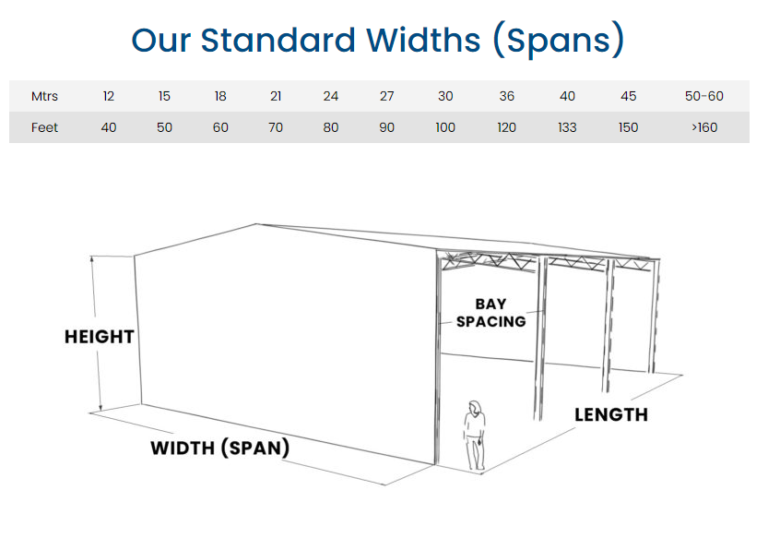Feedpad covers are set to play an important role in the future profitability and sustainability of Australian dairies.
Is your dairy operation ready for the journey?
More dairy farmers are covering their feedpads to reduce feed loss, improve cow health, comfort and performance, make management easier and make better use of their land – all of which contribute to the bottom line.
So, is a covered feedpad right for you?
It is important to consider how this infrastructure fits in with your current feeding system and infrastructure, herd size and long-term plans.
In this article, we discuss the top reasons behind covering feedpads, to help you work out if this right step for your dairy operation.
Frequently Asked Questions About Feedpad Covers – Answered
Quick answers to the top questions about covering a feedpad.
As the name suggests, an Action feedpad cover is a structural steel roof designed and built to cover either a compacted dirt surface or concrete feedpad.
Throughout Dairy Australia’s Contained Housing Guidelines, this is referred to as a “roofed feedpad.”
Feedpad covers are popular projects as dairy farmers look to increase productivity, profitability and sustainability, and make management easier.
Some of the ways a covered feedpad does this is by:
- Reducing feed wastage
- Lowering mastitis
- Improving working conditions
- Increasing milk production
You can learn about each of these benefits (and more!) in this article.
Yes, generally an Action feedpad cover can be designed and built to fit seamlessly in with your existing feedpad infrastructure.
This is done by conducting a thorough site measure that takes note of any site conditions that may impact the design or build process, such as nearby infrastructure or site slope.
Using this information, the column length and placement can be adjusted to work in with your feed bunks, water troughs and slope over the site.
When it comes to installation, the cover will either be “stick built” in the air, or built to the side and then craned into place.
If you are building over an existing feedpad, the size of your cover will largely be dictated by this.
However, if you are starting with a greenfield site it will be dictated by factors such as:
- The number of cows
- Bunk space requirements
- The length of time the cows will be in the feedpad
- Feed bunk layout (single or multiple rows)
If you intend to include a loafing area as part of the project, Dairy Australia recommends 9m² per cow for short term durations or 15m² for longer term.
Here are some size recommendations based on previous projects:
- Standard spans that work well include 15 metres (smaller scale set ups), 24 metres (medium scale set ups) and 40 metres (larger scale set ups).
- Canopies are a cost-effective way to increase the width and coverage of your shed – and can be used to avoid inconvenient column placement.
- The length will depend on the bay spacings and number of bays. 8 metre bay spacings (smaller scale setups) or 10 metre bay spacings (larger scale set ups with formed up columns) are popular.
- Heights between 5m and 6m are best, depending on the site exposure, orientation, machinery accessing the cover and whether the design includes gable infills, canopies or partial walls.
So, based on these suggestions, you could consider a 40m (L) x 15m (W) for a smaller scale set up, 68m (L) x 24m (W) for a mid-range set up or 140m (L) x 40m (W) for a larger set up.
For project specific size advice that takes into consideration your unique requirements, chat with one of the Action building consultants on 1800 687 888.
Broadly speaking, the best feedpad cover design is a “roof-only” configuration with:
- Optional gable infills to find the correct balance of airflow and weather protection
- Steep roof pitch (usually between 14 and 18 degrees) that works with an open ridge vent and an Action custom “pop top” ridge cover to provide effective ventilation
- Stormwater management using the Action custom gutter system (often plumbed to one end)
Plus, custom features such as canopies (for cost-effective coverage and different column placement) or formed up columns (to lower risk of injury at cow level) can be used to suit your operational requirements
However, the design will only be as effective as your planning around details like:
- Considering the local climate and site conditions
- Using best-practice orientation
- Ensuring compliant effluent management
For example, the orientation will directly influence the effectiveness of the roof design in keeping the cows cool. The recommended orientation is east-west and you can learn why here – What Is The Best Barn Orientation?
The average cost of a feedpad cover is approx. $460,000 with prices ranging from $160,000 to $760,000.
The cost of your project will depend on factors like size, location, council permits, configuration and how you choose to customise your cover.
For a greenfield site, you will also need to budget for any required approvals, site preparation, feedpad concreting, water troughs and tanks.
Still have questions? Our building consultants have answers!
Reach out on 1800 687 888 for best-practice and project specific advice.
We also recommend downloading the industry guidelines as these cover off on details like site selection, drainage and effluent management.
7 Benefits Of Feedpad Covers To Consider
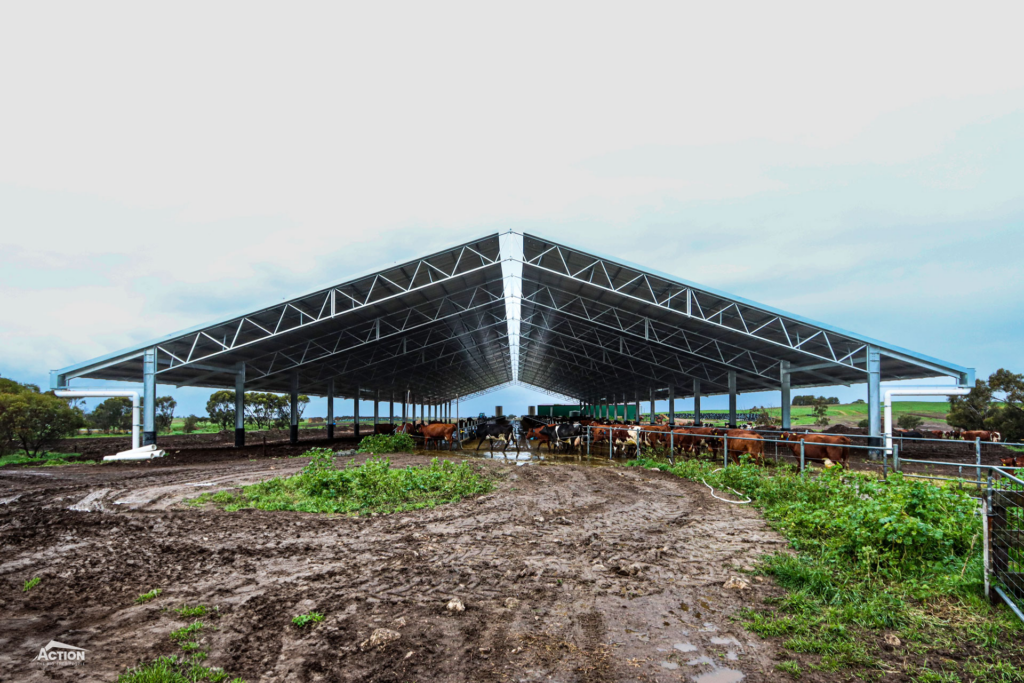
1
1. Reduce Feed Wastage
A covered feedpad with a well-designed feeding system reduces feed wastage by:
- Protecting feed from the weather – rain, hail or shine – ensuring it remains palatable and nutritious for longer
- Controlling access and reducing trampling
- Improving feeding efficiency and intake by reducing stress
According to Dairy Australia, a permanent, fully developed feedpad with concrete surfaces offers the lowest percentage of feed wastage – typically around 3% (based on dry conditions).
Covering your feedpad takes this to the next level and ensures the feed savings are consistent year-round and season to season.
It’s a win-win situation.
Protecting feed from the weather reduces spoilage and wastage, while improved cow comfort encourages higher, more consistent intake, leading to increased production and better returns on your feed investment.
This is one of the benefits Paula and Mick Gray have proved with their Action feedpad cover.
As shared in this Dairy Australia article, “they put in a covered concrete feedpad near the dairy to ensure the cows had consistent access to feed even in very hot or very wet conditions. This not only improved herd welfare and provided shelter from conditions, but it also reduced spoilage and waste.”
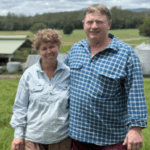
For more suggestions on how to reduce wastage and develop a realistic feed budget, download a copy of the Reducing Feed Wastage Costs Fact Sheet (PDF Download)
2
2. Capture Stormwater
A roof over your feedpad provides an excellent opportunity to capture stormwater run-off and use it in your dairy operation such as for floodwashing or growing fodder.
This can be a significant cost-saving measure, given the increasing input costs, including water prices.
It also helps provide a secure water supply and makes the most of rainfall received, which can prove valuable in dry seasons.
Finally, this demonstrates responsible water usage (an important consideration with greater public scrutiny on water usage in the industry) and contributes to a sustainable dairy operation.
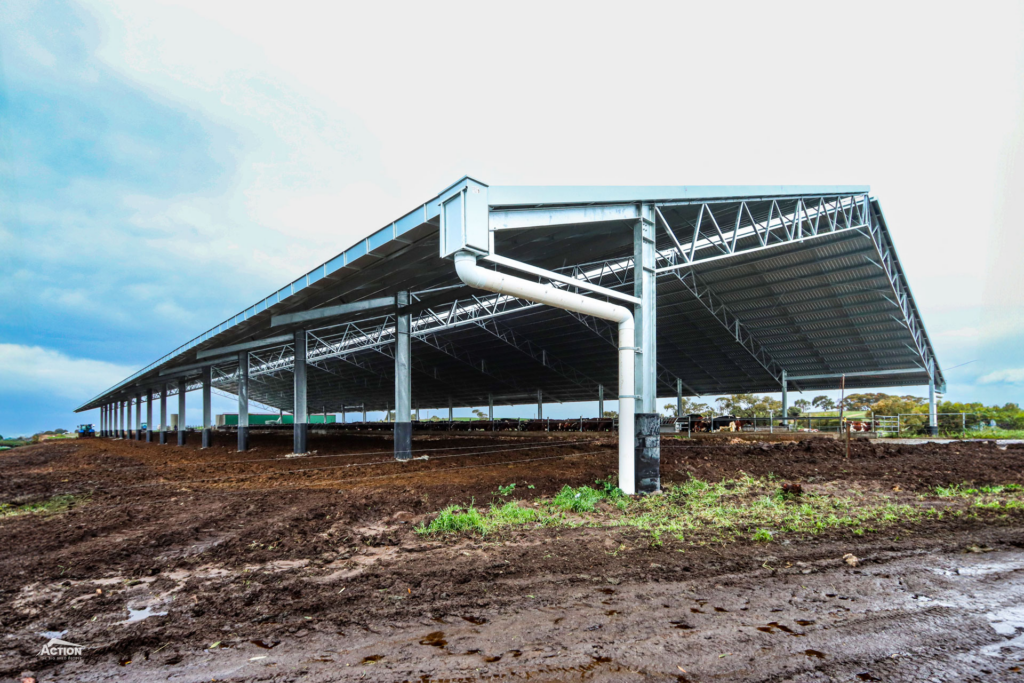
So, how much water can you capture from your feedpad roof?
This will depend primarily on the size of your roof and the annual rainfall.
For example, the 68m (L) x 24m (W) feedpad cover at Myall VIC, pictured below, could harvest approximately. 608,736 litres per year. (Based on an annual rainfall of 373 mm)
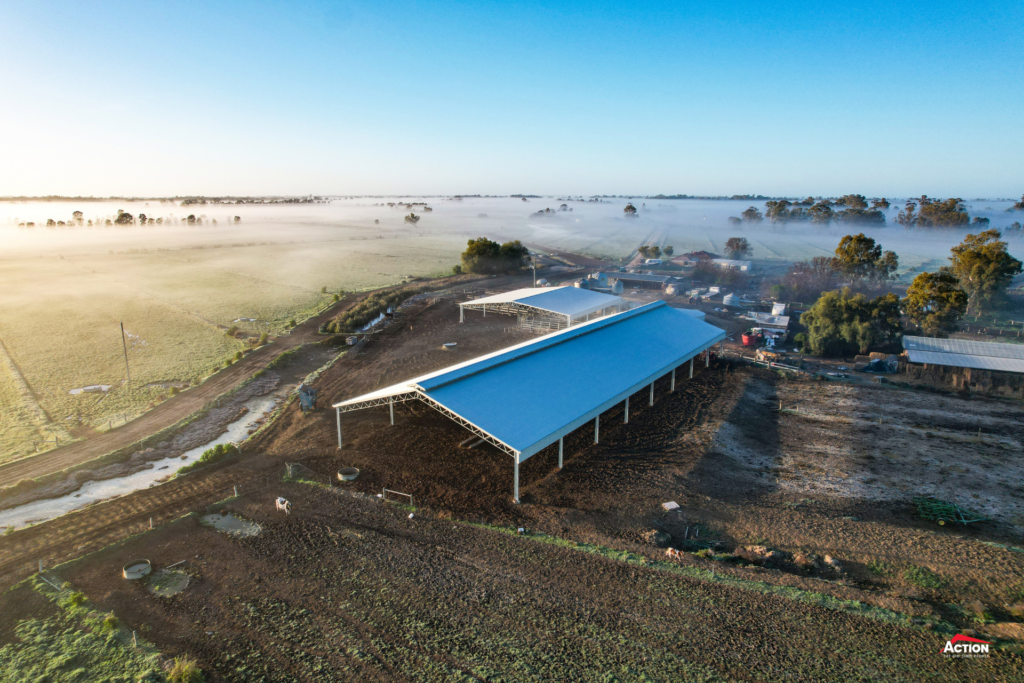
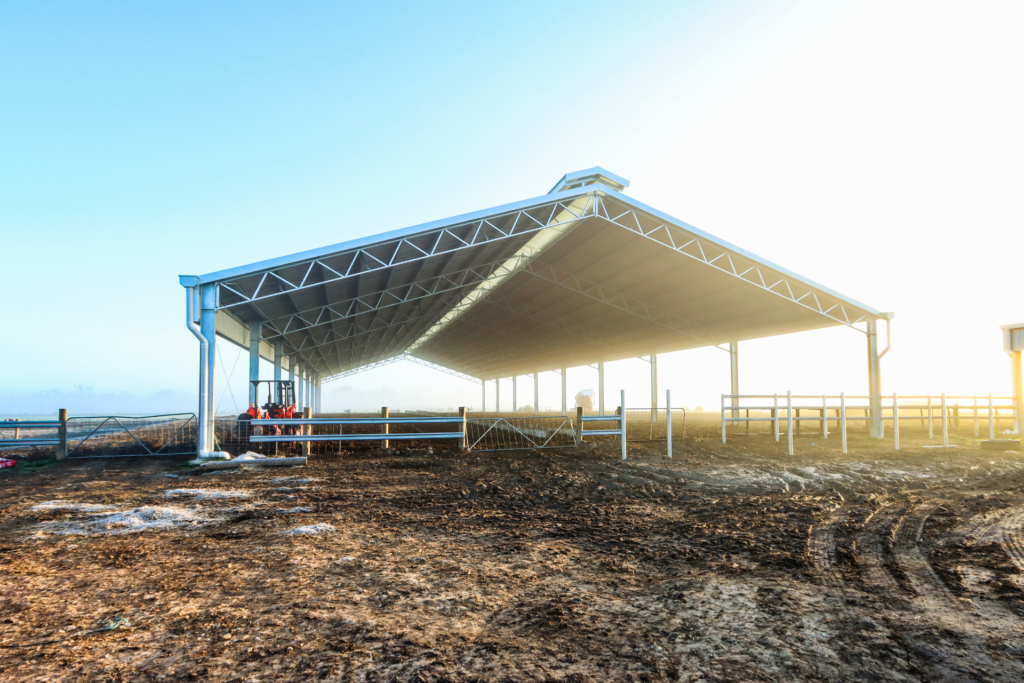
Try the calculator below to work out how much stormwater you could capture of your feedpad cover roof.
Rainwater Harvest Calculator
If you are wondering about the volume of rainwater you could potentially collect from a shed roof, use the stormwater calculator.
To make sure you are able to take full advantage of this opportunity, there are several details to consider when designing your stormwater system.
These include:
- Gutter design
- Site slope and/or gutter slope
- Storage tanks and location to meet EPA and fire design requirements
Our building consultants are available to provide advice on each of these points.
3
3. Lower Mastitis
A feedpad cover provides a cleaner and drier environment, which has been proven to improve overall herd health – including reducing cell count.
This is simply because wet and muddy conditions are the perfect breeding ground for bacteria.
Removing this lowers the risk of exposure and contamination of the udder and teats.
For Paula and Mick Gray this was an immediate benefit with the mastitis count improving significantly in just a few months.
“When the cows went in at the end of July, we were running at 180-190 (cell count). Now we’re under 100. We didn’t expect to see that for another 12 months. We’re really thrilled. Instantly the cows are telling us they’re happier and under less stress.”
Reducing mastitis also increases productivity, improves milk quality and reduces time and money spent on treatment.

4
4. Install Solar On The Roof
An Action feedpad cover roof provides the perfect surface to install solar panels – provided they have been engineered to suit solar panel loading.

Like our earlier discussion around stormwater catchment, using solar demonstrates a commitment to sustainability (by reducing emissions) and saves money (by reducing energy costs). Win-win!
5
5. Increase Labour Efficiency & Make Management Easier
Here’s another win-win situation to consider.
A feedpad cover eliminates the need to work with cows in boggy pastures or extreme heat.
This reduces stress, makes feeding cows faster, easier and less labour-intensive, and these improved working conditions play an important role in attracting and retaining quality staff.
This is increasingly valuable in a labour-poor industry and for dairy farmers looking to spend more quality time with their families.
We have seen similar themes of easier management and increased labour efficiency with loafing barns too. Lang Dairies’ loafing barn is a prime example – Loafing Barn System A Valuable Management Tool
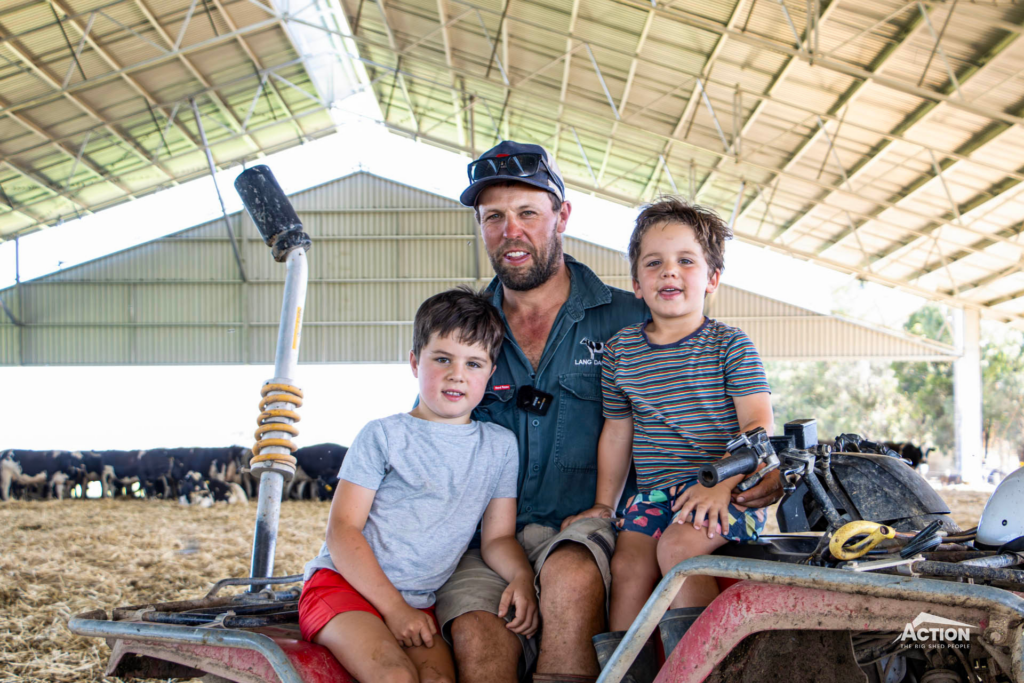
6
Improve Land Use
A covered feedpad can be used year-round to help you improve your pasture management and use your land sustainably and efficiently.
Firstly, a feedpad system reduces pugging and restores paddocks faster after wet weather events or drought conditions.
And when used with a loafing barn, your land can be used for cropping rather than grazing, and you could expand your dairy operation/increase cow numbers without having to increase the physical footprint
As land values continue to climb, particularly in prime dairy country, making the most of the land you have makes sense!
7
7. Maximise Milk Production
Comfortable cows produce more milk, and infrastructure like feedpad covers allows them to consistently produce more milk year-round.
How?
By eliminating dips in production caused by weather extremes and stress events.
For example, this comparison study in New Zealand found that a covered woodchip feedpad improved calving cow weights and body condition, and resulted in a 3% increase in milk production.

Consistent, high-performing yields ultimately increase your profitability.
So, a covered feedpad can provide significant and real, tangible benefits and is a smart investment for more profitable, more sustainable and future-ready dairy operations.
Looking for sustainable growth and consistent production?
Wanting to make management in the winter easier?
A feedpad cover could be the perfect fit.
Call 1800 687 888 to book a project consultation to learn more about the planning process and for design advice. We would love to hear from you!
